Elateridae
Click Beetles, Wireworms
Cleide Costa and Simone Policena Rosa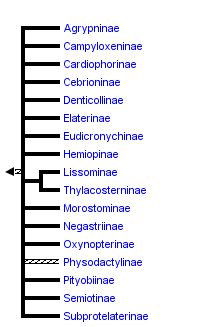


This tree diagram shows the relationships between several groups of organisms.
The root of the current tree connects the organisms featured in this tree to their containing group and the rest of the Tree of Life. The basal branching point in the tree represents the ancestor of the other groups in the tree. This ancestor diversified over time into several descendent subgroups, which are represented as internal nodes and terminal taxa to the right.

You can click on the root to travel down the Tree of Life all the way to the root of all Life, and you can click on the names of descendent subgroups to travel up the Tree of Life all the way to individual species.
For more information on ToL tree formatting, please see Interpreting the Tree or Classification. To learn more about phylogenetic trees, please visit our Phylogenetic Biology pages.
close boxIntroduction
The cosmopolitan family Elateridae is composed by about 400 genera and 10,000 species. They are recognized by an elongate, narrow body form, with a large and free articulated prothorax and usually serrate antennae.
Elateridae are known as “click beetles” by their ability to jump to the air while making a clicking noise; the jump is normally made from an inverted position and involves a sudden movement of the prosternal process into the mesoventral cavity. This mechanism may be used to “right” the beetle which lands on its back or as an escape reaction.
Adults are phytophagous consuming plant juices and are collected in the vegetation, by light and interception traps. Some species are bioluminescent in all life stages. The larvae are predaceous or phytophagous and live in rotten wood, soil, litter and insect nests. The life cycle usually is of two years duration.
In general it is easy to identify elaterid larvae to genus, but in many cases specific identification is achieved only by rearing larvae to the adult stage.
Characteristics
(based on Costa et al., 2010)

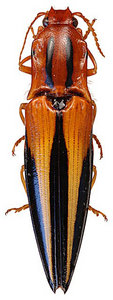
Semiotus illustris. © 2010 Le Coléoptériste / ACOREP-France
Adults
- Length 0.9–75.0 mm. Body moderately to very elongate. Head usually prognathous.
- Frontal region highly variable, not or only slightly declined to vertical or inflexed at apex, forming frontal carina.
- Eyes usually large and protuberant, often smaller in females, finely facetted, ommatidium of exocone type.
- Frontoclypeal suture absent. Labrum free.
- Antennae usually 11–segmented and serrate, sometimes pectinate, bipectinate or flabellate. Female antennae usually serrate when male antennae are flabellate or pectinate.
- Mandible uni or pluridentate; mola absent, mandibular base often with brush of hairs. Maxilla with galea and lacinia; labium without ligula.
- Posterior angles of pronotum produced. Promesothoracic interlocking mechanism almost always well developed.
- Prosternum with anterior edge produced forward to form chin piece. Prosternal process complete, extending well behind procoxae and fitting into deep mesoventral cavity.
- Notosternal suture complete, shallow or grooved, forming deep antennal cavity.
- Procoxae not projecting below prosternum; procoxal cavities separated; trochantin reduced, concealed or absent, endopleuron more or less fused to notum at base of notosternal suture.
- Hind wing with elongate radial cell and cross–vein r3, apical field usually with three sclerites forming an epsilon figure.
- Tarsi 5–5–5, tarsomeres often simple, sometimes with ventral pubescent pads or membranous lamellae.
- Abdomen with five ventrites, the first four of which are connate.
- Aedeagus trilobate, parameres with or without latero-apical hooks.
- Sternite VIII in female with long anteromedian strut (spiculum ventrale) and a pair of shorter anterolateral struts.
- Ovipositor usually with paraprocts longer than gonocoxites, styli usually present and subapical.

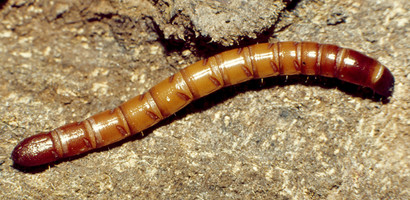
Elaterinae / Dicrepidiini larva © 2011
Larvae
- Body elongate, parallel–sided, flattened to cylindrical; surfaces generally smooth, but sometimes with tubercles, transverse carinae or patches of specialized setae; vestiture usually consisting of fine hairs or setae only.
- Head prognathous, flattened; epicranial stem very short; frontal arms lyriform. Stemmata often absent, sometimes with a single stemma (eye spot) on each side.
- Labrum completely fused to anterior edge of frontoclypeal plate produced to form a medial nasale consisting of one to several teeth and a pair of adnasalia.
- Antennae 3–segmented with conical, palpiform or dome–like sensorium on preapical antennomere.
- Mandibles symmetrical, falcate, unidentate to tridentate, without accessory ventral process; incisor edge simple or with 1 or 2 teeth or heavily sclerotized retinacula. Mesal surface with penicillum.
- Ventral mouthparts retracted; maxillary articulating area absent. Labium consisting of prementum and postmentum, connate with maxillae to form maxillolabial complex; ligula present.
- Thoracic segments with tergal plates. Prothoracic venter with subtriangular presternal plate.
- Legs 5–segmented, including pretarsus, which is claw–like, usually with 2 setae lying side by side or obliquely situated.
- Abdominal segment IX not forming articulated plate, extending onto ventral surface, so that segment X is ventrally or posteroventrally oriented; tergum IX highly variable, with paired bifurcate urogomphi.
- Segment X forming short, cylindrical pygopod, which is flanked by paired teeth or hooks.
- Spiracles biforous (bilabiate), without closing apparatus.


Horistonotus sp. larva © 1988 Cleide Costa
Taxonomy
Elateridae has been considered to be a natural group since the earliest classifications of Coleoptera, first as a tribe of the Sternoxi (Latreille 1804, 1825) and then as a family (Lacordaire, 1857). The vast majority of elaterid genera appear to form a monophyletic group, but the outer limits of Elateridae have still not been conclusively defined.
The elaterid subfamilies were originally defined on superficial adult characteristics, (Lacordaire, 1857; Candèze, 1857, 1859, 1860, 1863, 1874; Schwarz, 1906 a, b, 1907 a, b; Fleutiaux, 1947). Hyslop (1917, 1923) first made use of larval features to define elaterid subfamilies. Classifications based on specific adult character systems were produced by Gur’yeva (1974) and Dolin (1975, 1978). These authors considered 10 subfamilies: Agrypninae, Pityobiinae, Oxynopterinae, Diminae, Tetralobinae, Negastriinae, Denticollinae (as Athoinae), Oestodinae, Elaterinae and Cardiophorinae.
Lawrence (1988) analyzed phylogenetic relationships among the families of Elateriformia and, based on larval and adult characters, proposed the inclusion of Cebrionidae within Elateridae as a subfamily. Beutel (1995) also asserted the close relationship between cebrionids and elaterids.
In the classification of Lawrence & Newton (1995) Elateridae was divided into 18 subfamilies: Cebrioninae, Tetralobinae, Thylacosterninae, Lissominae, Semiotinae, Pityobiinae, Oxynopterinae, Agrypninae, Denticollinae, Negastriinae, Diminae, Elaterinae, Cardiophorinae, Hemiopinae and Physodactylinae, Eudicronychinae, Anischiinae and Subprotelaterinae, the last three of which were of uncertain position.
Discussion of Phylogenetic Relationships

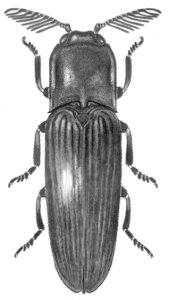
Pseudotetralobus murrai. © 1992 Cleide Costa, Revista Brasileira de Entomologia (RBE)
In Muona’s analysis (1995), Elateridae, as usually delimited, is paraphyletic, with Throscidae as a derived, monophyletic group within the elaterid clade. The relationship between Elateridae and Eucnemidae was confirmed by Lawrence et al. (1995) in an analysis of 34 exemplar genera of Elateriformia.
Calder et al. (1993), in a strict consensus cladogram of nine elaterid subfamilies, found the following clade (((Pityobiinae + Agrypninae) (Cardiophorinae + Elaterinae)) + Denticollinae) formed part of a polytomy with Lissominae, Thylacosterninae, Semiotinae, Tetralobinae, Cebrioninae.
Sagegami- Oba et al. (2007) in the first molecular study of 77 elaterid species in 57 genera based on partial sequence of nuclear 28S ribosomal DNA found four distinct clades: Elaterinae (including Melanotini) basal to the remaining members of the family, Agrypninae, basal to (Negastriinae + Cardiophorinae) + Denticollinae (including Hypnoidini, Campsosternus and Pectocera Hope). A similar topology was arrived at by Oba (2007) using Bayesian analysis. Lawrence et al. (2007), based on both morphological and molecular data found that Thylacosterninae and Lissominae consistently form a monophyletic group within Elateridae.
Other Names for Elateridae
- Vernacular Names: Click Beetles, skip-jack, spring-beetles, clicker, elaters, Wireworms
References
Beutel, R. G. 1995. Phylogenetic analysis of Elateriformia (Coleoptera: Polyphaga) based on larval characters. Journal of Zoological Systematics and Evolutionary Research 33: 145–171.
Calder, A. A. 1998. Coleoptera: Elateroidea. In Wells, A. (ed.) Zoological Catalogue of Australia. Volume 29.6. 248 pp. CSIRO Publishing, Melbourne.
Calder, A. A., Lawrence, J. F. & Trueman, J. W. H. 1993. Austrelater, gen. nov. (Coleoptera: Elateridae), with description of the larva and comments on elaterid relationships. Invertebrate Taxonomy 7: 1349–1394.
Candèze, E. 1857. Monographie des Élaterides. Vol. 1. Mémoires de la Société Royale des Sciences de Liège 12: viii + 400 pp, 7 pls.
Candèze, E. 1859. Monographie des Élaterides. Vol. 2. Mémoires de la Société Royale des Sciences de Liège 14: 543 pp., 7 pls.
Candèze, E. 1860. Monographie des Élaterides. Vol. 3. Mémoires de la Société Royale des Sciences de Liège 15: 512 pp, 5 pls.
Candèze, E. 1863. Monographie des Élaterides. Vol. 4. Mémoires de la Société Royale des Sciences de Liège 17: 534 pp., 6 pls.
Candèze, E. 1874. Revision de la monographie des Élaterides. Mémoires de la Société Royale des Sciences de Liège (2) 4: viii + 218 pp.
Chassain, J. & J. Touroult. 2010. Les Élatérides de Guyane (Coleoptera, Elateridae) in Touroult, J. Contribution à l'étude des coléoptères de Guyane, Tome II (Supplement au Bulletin de liaison d’ACOREP-France "Le Coleopteriste"), ACOREP- France, Paris, 30 p.
Costa, C., J. F. Lawrence & S. P. Rosa. 2010. Elateridae Leach, 1815. In R. G. Beutel; R. A. B. Leschen (Org.). Handbook of Zoology, Vol. IV, Arthropoda: Insecta, Coleoptera: Evolution and Systematics (Polyphaga Part). Jena, Friedrich-Schiller-Universität Jena.
Dolin, V. G. 1975. Wing venation of click beetles (Coleoptera, Elateridae) and its importance for taxonomy of the family. Zoologicheskii Zhurnal 54: 1618–1633.
Dolin, V. G. 1978. Phylogeny of click beetles (Coleoptera, Elateridae). Vestinik Zoologii 1978 (3): 3–11.
Fleutiaux, E. 1947. Révision des Élatérides (Coléoptères) de L’Indo–Chine Française. Notes d’Entomologie Chinoise 11: 233–420.
Girard, C. 1972. Contribution a l'étude des Elateridae de l'Afrique noire (Col.). Bulletin de la Société Entomologique de France 17: 276-283.
Gur'yeva, Ye. L. 1974. Thoracic structure of click beetles (Coleoptera, Elateridae) and the significance of the structural characters for the system of the family. – Entomologicheskoye Obozreniye 53: 96–113. (in Russian; translation in Entomological Review, Washington 53: 67–79).
Hayek, C. M. F. von 1990. A reclassification of the Melanotus group of genera (Coleoptera: Elateridae). Bulletin of the British Museum of Natural History (Entomology) 59(1): 37–115.
Hyslop, J. A. 1917. The phylogeny of the Elateridae based on larval characters. – Annals of the Entomological Society of America 10: 241–263.
Hyslop, J. A. 1923. The present status of the coleopterous family Plastoceridae. Proceedings of the Entomological Society of Washington 25: 156–160.
Johnson, P. J. 2002. 58. Elateridae Leach 1815. Pp. 160–173 in Arnett, R. H., Jr., Thomas, M. C., Skelley, P. E. & Frank, J. H. (eds.) American Beetles. Volume 2. Polyphaga: Scarabaeoidea through Curculionoidea. CRC Press, Gainesville, Florida.
Lacordaire, J. T. 1857. Histoire Naturelle des Insectes. Genera des Coléoptères ou exposé méthodique et critique de tous le genres proposés jusqu’ici dans cet ordre d’insectes, Vol. 4, 579 pp. Librairie Encyclopédique de Roret, Paris.
Latreille, P. A. 1804. Histoire Naturelle, Génerale et Particulière des Crustacés et des Insectes. Familles Naturelles des Genres. F. Dufart, Paris.
Latreille, P. A. 1825. Familles Naturelles du Régne Animal, Exposées Succinctemente et dans un Ordre Analytique, avec L’Indication de leurs Genres. Baillière, Paris.
Lawrence, J. F. 1988. Rhinorhipidae, a new beetle family from Australia, with comments on the phylogeny of the Elateriformia. Invertebrate Taxonomy 2 1987: 1–53.
Lawrence, J. F. & Newton, A. F., Jr. 1995. Families and subfamilies of Coleoptera (with selected genera, notes, references and data on family–group names). Pp. 779–1006 in Pakaluk, J. & Ślipiński, S. A. (eds) Biology, Phylogeny, and Classification of Coleoptera: Papers Celebrating the 80th Birthday of Roy A. Crowson, Vol. 2. Muzeum i Instytut Zoologii PAN, Warszawa.
Lawrence, J. F., Nitisky, N. B. & Kirejtshuk, A. G. 1995. Phylogenetic position of Decliniidae (Coleoptera: Scirtoidea) and comments on the classification of Elateriformia (sensu lato). Pp. 375–410 in Pakaluk, J. & Ślipiński, S. A. (eds) Biology, Phylogeny, and Classification of Coleoptera: Papers Celebrating the 80th Birthday of Roy A. Crowson, Vol. 1. Muzeum i Instytut Zoologii PAN, Warszawa.
Lawrence, J. F., Muona, J., Teräväinen, M., Ståhls, G. & Vahtera V. 2007. Anischia, Perothops and the phylogeny of Elateroidea (Coleoptera: Elateriformia). Insect Systematics and Evolution 38: 205–239.
Muona, J. 1995. The phylogeny of Elateroidea (Coleoptera), or which tree is the best? Cladistics 9: 413–426.
Oba, Y. 2007. Molecular phylogenetic analysis of click beetles (Coleoptera: Elateridae). Coleopterists’ News 157: 7–10 (in Japanese; English summary).
Sagegami–Oba, R., Oba, Y. & Ôhira, H. (2007: Phylogenetic relationships of click beetles (Coleoptera: Elateridae) inferred from 28S ribosomal DNA: Insights into the evolution of bioluminescence in Elateridae. Molecular Phylogenetics and Evolution 42 (2): 410–421.
Schwarz, O. 1906a. Genera Insectorum de P. Wytsman. Fasc. 46A. Coleoptera. Fam. Elateridae. Pp. 1–112. P. Wytsman, Brussels.
Schwarz, O. 1906b. Genera Insectorum de P. Wytsman. Fasc. 46B. Coleoptera. Fam. Elateridae. Pp. 113–224. P. Wytsman, Brussels.
Schwarz, O. 1907a. Genera Insectorum de P. Wytsman. Fasc. 46C. Coleoptera. Fam. Elateridae. Pp. 225–370, pls. 1–6. P. Wytsman, Brussels.
Schwarz, O. 1907b. Genera Insectorum de PI. Wytsman. Fasc. 50. Coleoptera. Fam. Plastoceridae. 10 pp., 1 pl. P. Wytsman, Brussels.
Stibick, J. N. L. 1971. The generic classification of the Negastriinae (Coleoptera, Elateridae). Pacific Insects 13 (2): 371–390.
Stibick, J. N. L. 1979. Classification of the Elateridae (Coleoptera). Relationships and classification of the subfamilies and tribes. Pacific Insects 20 (1): 145–186.
Title Illustrations

| Scientific Name | Lacon conspersus |
|---|---|
| Specimen Condition | Dead Specimen |
| Identified By | Kirill V. Makarov |
| Sex | Male |
| Life Cycle Stage | adult |
| View | dorsal |
| Copyright | © 2011 Kirill V. Makarov |
| Scientific Name | Athous subfuscus |
|---|---|
| Specimen Condition | Dead Specimen |
| Identified By | Kirill V. Makarov |
| Sex | Male |
| Life Cycle Stage | adult |
| View | dorsal |
| Copyright | © 2011 Kirill V. Makarov |
| Scientific Name | Ampedus pomonae |
|---|---|
| Specimen Condition | Dead Specimen |
| Identified By | Kirill V. Makarov |
| Sex | Male |
| Life Cycle Stage | adult |
| View | dorsal |
| Copyright | © 2011 Kirill V. Makarov |
| Scientific Name | Balgus schnusei cayennensis |
|---|---|
| Comments | Photograph by J. Touroult (Chassain & Touroult, 2010) |
| Creator | J. Touroult |
| Specimen Condition | Dead Specimen |
| Identified By | J. Chassain & J. Touroult |
| Sex | Male |
| Life Cycle Stage | adult |
| View | dorsal |
| Size | 20-26 mm |
| Copyright | © 2010 Le Coléoptériste / ACOREP-France |
About This Page
We thank Kirill V. Makarov (Moscow Pedagogical State University) and J. Chassain and J. Touroult for permission to use their photographs; the Conselho Nacional de Desenvolvimento Científico e Tecnológico (CNPq) for the Research Grant 302721/2007 – 0 to C. Costa.
Cleide Costa

Museu de Zoologia, Universidade de São Paulo, Brasil

Museu de Zoologia, Universidade de São Paulo, Brasil
Correspondence regarding this page should be directed to Cleide Costa at and Simone Policena Rosa at
Page copyright © 2011 Cleide Costa and
 Page: Tree of Life
Elateridae. Click Beetles, Wireworms.
Authored by
Cleide Costa and Simone Policena Rosa.
The TEXT of this page is licensed under the
Creative Commons Attribution-NonCommercial License - Version 3.0. Note that images and other media
featured on this page are each governed by their own license, and they may or may not be available
for reuse. Click on an image or a media link to access the media data window, which provides the
relevant licensing information. For the general terms and conditions of ToL material reuse and
redistribution, please see the Tree of Life Copyright
Policies.
Page: Tree of Life
Elateridae. Click Beetles, Wireworms.
Authored by
Cleide Costa and Simone Policena Rosa.
The TEXT of this page is licensed under the
Creative Commons Attribution-NonCommercial License - Version 3.0. Note that images and other media
featured on this page are each governed by their own license, and they may or may not be available
for reuse. Click on an image or a media link to access the media data window, which provides the
relevant licensing information. For the general terms and conditions of ToL material reuse and
redistribution, please see the Tree of Life Copyright
Policies.
- First online 26 February 2011
- Content changed 26 February 2011
Citing this page:
Costa, Cleide and Simone Policena Rosa. 2011. Elateridae. Click Beetles, Wireworms. Version 26 February 2011. http://tolweb.org/Elateridae/9190/2011.02.26 in The Tree of Life Web Project, http://tolweb.org/





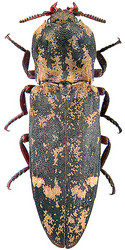
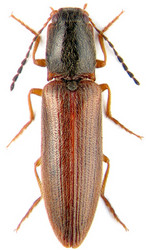
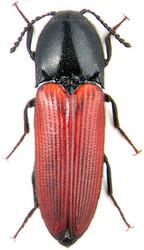

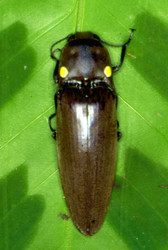
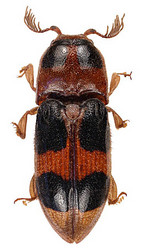





 Go to quick links
Go to quick search
Go to navigation for this section of the ToL site
Go to detailed links for the ToL site
Go to quick links
Go to quick search
Go to navigation for this section of the ToL site
Go to detailed links for the ToL site